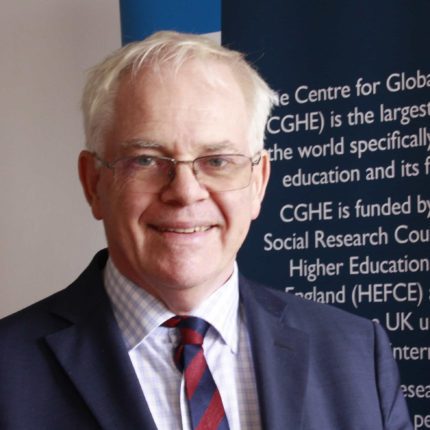What does higher education achieve beyond the provision of pecuniary benefits for individuals, meaning superior opportunities for work, earnings, career and social position?
How do we understand the public or common good in this sector, including effects of higher education experienced collectively as well as severally?
These are not easy questions. Research by the Centre for Global Higher Education (CGHE) finds that the answers vary by country, according to political culture and policy history. This article reports the findings concerning higher education and public good in England.
We reviewed successive policy reports to trace the evolution of thinking about higher education and public good. We also interviewed a varied group of 24 people, engaged in policy making and regulation, in national education organisations and media, in contrasting universities (a large global player and a primarily regional provider), and in academic study of higher education. The interviewees all believed that the question of higher education and public good was important. However, they struggled to find a language for discussing it.
The economic formula
Among the four nations of the UK, England is unique in the extent to which the policy approach to higher education and public good are determined by economic ideas. A 1954 paper by American economist Paul Samuelson, “The pure theory of public expenditure”, is remarkably influential. With the advent of neoliberal policy in the 1980s and 1990s it captured the Treasury, and in the highly centralised English polity the Treasury mostly sets the rules.
For Samuelson, activity in spending portfolios such as education and health is economic activity – and in a capitalist society, all economic activity is (or should be) normally realised in the form of private goods and market transactions. If it is impossible to generate profit in any one domain, there is market failure. Then the goods or services, if they are to be produced at all, must take the form of public goods financed by government or philanthropy.
This has two implications. First, there is a zero-sum relation between private and public goods. Mission, activity and benefits are either private or public in nature. Second, there is a tight nexus between on one hand mission and activity in higher education, the “goods” or benefits it provides, and on the other hand its funding (private or public). Higher education is seen as transactional, financing in exchange for services, a market economy concept.
The implication of Samuelson’s work is that British higher education should be produced in markets wherever possible and with minimal tax-funded provision and cost. This has never been fully applied. The Blair and Brown Labour governments treated higher education as a mix of public and private goods. In the 2012 reforms that created the present high fee market system, the Coalition government supplemented student fees with financing to sustain access to individual opportunity (i.e. access to what was seen as a private good), through student loans and grants.
All governments have treated basic research as a Samuelson public good and financed it publicly. The REF focuses on social as well as economic impact. There are episodic policy gestures towards ill-defined “third stream” or “engagement” missions, though without much money attached to them.
But governments have primarily focused on private earnings and employability as the core rationale for higher education. The private benefits have been mobilised to justify fees, and differentiate courses and institutions on the basis of the value attributed to graduation.
The abiding weakness of this formula is that it underplays all contributions, effects, outcomes and values in higher education that are not Samuelson private goods. This is a much larger domain than Samuelson’s residual category of minimum necessary public goods would suggest. These goods include the non-pecuniary effects of education for individual students such as self-formation through engagement in knowledge and the augmentation of reflexive agency and sociability. They also include the many impacts of the sector in collective social relations, like the population-wide fostering of literacy and technological capabilities, public health, compliance with law and enhanced political connectedness; tolerance of difference, international relations; economy-building and society-building in regions and cities; and so on. There is much research on the effects of higher education in all of these areas. But they are not funded as policy objectives. The sector’s many specific contributions to the public, common and collective social dimension have largely dropped off the policy template.
Successive policy reports
How did this happen? The CGHE research looked closely at the landmark reports of Robbins in 1963, Dearing in 1997 and Browne in 2010. To bring the discussion to the present we added the 2019 Augar report, not a watershed but again, a window into the mind of government.
The 1963 Robbins report introduced and normalised the principle that all qualified students who aspired to higher education should be able to enter. No UK report on higher education has carried greater weight. It ignited a latent idealism even at the Treasury, as was noted at the time. Significantly, however, Robbins explicitly rejected the later Treasury approach. It did not see public and private goods as zero sum. Nor did it tie its judgements about the mixed public and private outcomes of higher education to a funding formula. Robbins saw government as funding both the public and private benefits. It rejected the financing of the growing higher education system by fees and student loans. “It is a bad thing … for young people to emerge with a load of debt,” it stated. “The connection between higher education and earning power can be over-stressed.” Loans financing would discourage participation.
Robbins saw the individual contribution to financing as contained within collective financing. Individual beneficiaries earning higher incomes would carry part of the cost of higher education by paying the higher level of general income tax that flowed from their earnings.
The 1997 Dearing committee met amid the advocacy of neoliberal business and market models. Nevertheless, it conceived of the sector in broad terms. The purposes of higher education were to enable the development of individuals, to expand knowledge, “to serve the needs” of the economy, and “to play a major role in shaping a democratic, civilised, inclusive society.” Higher education should “enable society to make progress through an understanding of itself and its world.” This suggested a broadly conceived mission to further the public good. However, Dearing also proposed tuition fees financed by income contingent student loans in what had been a free system. To justify this, it developed a narrative that (a) defined higher education as economic not social, conflicting with much of the report, and (b) tightly linked economic outcomes, seen as predominantly private, to financing:
There is overwhelming evidence that those with higher education qualifications are the main beneficiaries from higher education in the form of improved employment prospects and pay… graduates in employment should make a greater contribution to the costs of higher education in the future. While we believe the economy as a whole, and those who employ graduates, are also substantial beneficiaries, even though these benefits have proved elusive to quantify, the greatest benefit accrues to graduates themselves.
The 2010 Browne report proposed the largest transformation since Robbins. Like Dearing it began by couching the role of higher education in broad social and cultural terms: “higher education … helps to create the knowledge, skills and values that underpin a civilised society.” This broad role was no further defined and the report immediately followed this passage with discussion of the pecuniary benefits for individuals, joined to economic calculations of the value of those benefits. Browne moved English higher education from a mixed private/public funded system to a universal quasi-market with full price tuition fees, supported by government-supported income contingent loans so that most students would not have to pay in the year of study. The implication of the report was that the broad-based public outcomes of higher education would now be financed by individualised tuition payments. “With public resources now limited, new investment will have to come from those who directly benefit from higher education,” it stated. A modified version of the full fee Browne scheme was implemented in 2012. The government would carry the costs of former students whose incomes failed to trigger full loan repayment, but this was ideologically downplayed.
The shift from Robbins to Browne report reversed the private/public relation in funding and in the process emptied out the public good role of higher education. Robbins expected government to carry the cost of producing both private and public benefits. Browne advocated the individualised private funding of what once were seen as public benefits. Strikingly, whereas the economic justification for private funding was grounded in the argument about predominantly private benefits, the underlying political logic was actually reversed. It was the Treasury’s desire to introduce and then increase tuition fees that powered the shift in the definition of outcomes, from a public/private mix to largely private.
The 2019 Augar committee emphasised a combined tertiary approach, which was welcome, but followed the standard Treasury line on tuition. It did not make a broad-based statement of the contributions of higher education as Dearing and Browne had done. Its focus was on “enhancing value for money” in a system that “incentivises choice and competition”. However, in one boxed paragraph the Augar committee showed a glimpse of something larger:
Successful outcomes for both students and society are about more than pay. Higher levels of education are associated with wider participation in politics and civic affairs, and better physical and mental health. We also understand the social value of some lower-earning professions such as nursing and social care, and the cultural value of studying the Arts and Humanities. The earnings data enable us to make economically defined value calculations, not value judgements. Assessing this wider value is very difficult but government should continue to work to ensure that wider considerations are taken into account in its policy and funding decisions.
That was as far as it went. The Augar committee knew higher education generated public goods and its “wider value” should be recognised but had no idea how to do it.
Interviews with universities and policy makers
The Augar report’s irresolution showed that English policy no longer had the tools for investigating or regulating the public good role of higher education. Policy lacked a language of public good. The clarity and inclusive confidence of Robbins, and the breadth and diversity of Dearing, had vanished. The lack of policy language showed itself also in the CGHE research interviews with universities, policy makers and others.
There was no single understanding among our UK interviewees of the public good, or public goods as distinct from private goods. But the answers were not neoliberal. More than half the interviewees developed an expansive, albeit ill-defined, domain of public action or public relations, sometimes linked to ideas of grassroots democracy:
The public good is something that… transcends individual utility, individual perspective, and provides some benefit for society as a whole… that means all of us, independently of whether we individually get benefit (Mid-level manager, global research university, computing).
Interviewees emphasised that even the individualised outcomes of higher education were broader than private pecuniary benefits. There was a public good component in the education of individuals as capable, socialised and autonomous persons. One national journalist remarked that higher education can turn students “from someone who feels like they have no agency in their life, or they have very few choices, into someone with lots of agency and lots of choices. That is very powerful.”
A strong message from the interviewees was that an undue focus on individual pecuniary benefits narrowed the recognised mission. There was also almost universal push-back against the Samuelson economic idea that the private and public outcomes of higher education are zero-sum. Interviewees, including the economically trained, asserted that the benefits of higher education were both private and public, and both individual and collective. This view was expressed by all but one of the policy makers interviewed – though it must be said that there were no current Treasury officers in the interviewee group.
Public and private benefit are not necessarily antagonistic, or choices, they can both be advanced… in some cases the overlap is very clear (Mid-level manager, global university, literature).
There’s no doubt that on average that university education provides a significant private return to students, but it’s hugely heterogeneous… higher education provides private returns but also provides huge social returns. I don’t think it’s a zero-sum game (Academic expert in the economics of education).
Yet the commitment to public good wavered when discussion moved from the outcomes of higher education to its financing. Financing by definition is zero-sum. It must be either public or private. And no interviewee questioned the shared transactional premise of a tight nexus between on one hand the goods or benefits that higher education provides and on the other hand its funding, private or public. Interviewees wanted Robbins outcomes but had resigned themselves to Browne financing, so they found themselves being pulled back to the Treasury view of a limited scope for public good, contradicting their earlier statements about the role of higher education. This led to confusion and to judgments that lacked foundation.
It was also chronically difficult to establish the funding line. What share was right and just? 70 per cent private? 50 per cent? 30 per cent? Most saw the public/private split of costs as arbitrary. The boundaries between public and private costs, between government and institutional responsibilities, and between private and public goods, were all unstable in people’s minds. The economic formula had failed to provide coherence – though the formula had served policy purposes, in that it limited the extent to which higher education was seen to generate public good, and could be readily tweaked to meet short-term fiscal and political goals.
Breaking the nexus between funding and outcomes
In higher education in England there is an acute shared understanding of the private earnings and employment rates seen to be associated with graduation. But there is no clear consistent understanding of the outcomes of higher education seen to be public. The UK has no shared policy language for talking about higher education outcomes other than individualised economic benefits. A larger policy language was emptied out in the passage from Robbins to Augar and the corresponding ministerial discourse. The policy vision has been hijacked by the Treasury’s 30-year drive to advocate and implement tuition fees.
Unless there is a clearcut stance on the private/public shares of tuition cost (e.g. either free education, a pure private market with no subsidies, or a firmly policed 50/50 split to normalise shared funding), the financing of tuition will remain politicised and volatile. But the more important question is what to do about the public good role of higher education.
There was shared recognition across the CGHE interview group, among policy makers as well as the rest, that the balance had tipped much too far to the private side. One current policy maker remarked that in an environment in which institutions were focused on their self-interest as corporations, the orientation to the public good was an important corrective:
It’s absolutely necessary for universities to pay more attention to the public good, just as a defence against the probably unjustified accusations that there’s too much private interest in what universities do. It’s also a natural bulwark against governments of whatever kind.
But to pay attention to the public good it is crucial to break the nexus between the public/private division of funding, and the understanding of outcomes – to recognise that regardless of the ratio of public and private costs, higher education generates a wide range of public and private goods, and all should be nurtured by policy and institutions.
We are unlikely to return to Robbins funding. However, we can free up policy and practice by returning to the crucial Robbins insight that there is no essential link between the financing of higher education and the definition of outcomes and purposes in higher education.
Public good is not transactional and is produced by social policy not economic formulae. Bringing open-ended public good back onto the agenda will be opposed by the Treasury, which wants to limit the obligations of government, but will meet the needs of everyone else.














Universities are also charities and required to demonstrate public benefit for which they receive fiscal advantages. Contributing to the common wealth, both financially and symbolically, ‘should’ be at the core of their mission.
Are English people interested in anything other than money?
I don’t have time now to look up the reference for this, but this was one of the reports commissioned by David Willetts in the early 2010s – he didn’t only raise the fee. The calculation at the time was that private-public stood in a ratio of 2-1 (ie 67%-33%), which might actually have justified a RAB charge of 35% or so. It was a surprisingly nuanced reflection, even if I didn’t accept the basis for it happening at all